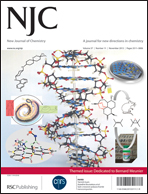Structural, electronic and photophysical properties of analogous RNA nucleosides: a theoretical study
Abstract
We use first-principles density functional theory (DFT) and time-dependent DFT (TDDFT) calculations to investigate the structural, energetic and bonding aspects, and optical properties of two analogues of RNA


 Please wait while we load your content...
Please wait while we load your content...